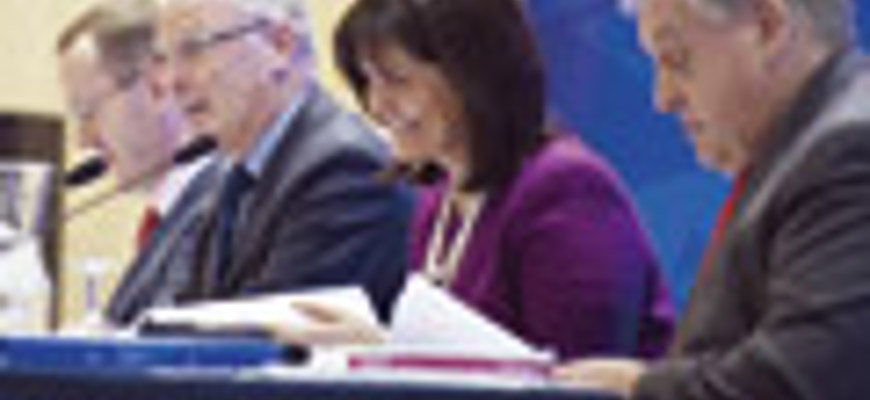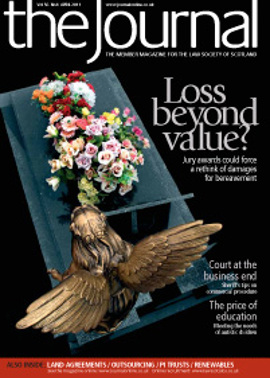Searching for a constitution

The search for a new constitution for the Law Society of Scotland was continuing as the Journal went to press, with talks due to be held between the Society and the Scottish Law Agents Society (SLAS) on whether amendments could be agreed to the draft put to the Law Society’s AGM on 25 March.
At that meeting a motion to rescind the current constitution from midnight on 31 May, subject to the passing of the draft scheme laid before the meeting, failed to achieve the necessary two thirds majority, voting (including proxies) being 820 for to 743 against, with nine abstentions.
As a result, the Society’s office bearers withdrew the following motion on the agenda, for adoption of the new scheme; but in truth the debate had already canvassed the principal issues and objections.
Vice President Cameron Ritchie, moving the motion to rescind, said the new draft would allow the governance of the Society “to be brought into the 21st century”. It had been three years in the planning, the Society had listened to members through consultations and a members’ survey, and it was better to go for a new model than to try and amend the existing one. If the motion failed to pass, the Society would have to come back and try again.
Supporting, his successor elect Austin Lafferty said it was the profession’s members that would make it survive and prosper, by coming to meetings, keeping themselves informed and taking part in the Society’s work. That was what would make the constitution work.
Walter Semple, however, moving the negative, described the draft as “entirely unsatisfactory” on three grounds. Many drafting criticisms remained unaddressed; there was a significant question whether it was actually needed for the creation of the new Regulatory Committee required under the Legal Services (Scotland) Act 2010, as claimed in a letter by Council members including the President in a letter to Glasgow constituents nine days before the meeting; and most importantly because of the conflict of interest that would result if the Society became a regulator of legal services providers under the Act. Members would not have to be consulted on rules to regulate such providers, but would have to share with them the Master Policy and Guarantee Fund, and both would be put at risk.
As the debate proceeded, most voices from the floor were critical. Mike Dailly (Govan Law Centre) said the Society was a membership organisation but the new constitution would reduce the rights of members and went against the modern movement towards more transparency and democracy. Craig Bennet, speaking as a SLAS council member and as an individual, said there was no level playing field if ordinary members needed a two thirds majority to pass a motion compared with the Council’s simple majority; and the article 16 provision on standing orders “may be a recipe for governance by stealth”. Former President David Preston pointed out that non-practising members of the Society were “systematically disenfranchised” from standing as or voting for Council members, but might have much to contribute at a time when pressures on business are increasing and people’s time is restricted. George MacWilliam of the Highlands Faculty also criticised various effects on members’ rights and added that there was an issue over elections to Council from different parts of his area.
Although John Loudon (Lindsays) emphasised the need for change and the improvements in the new draft over the current model, and Past President Ian Smart reminded the meeting that this was not a re-run of the ABS debate and there was a risk that some big firms could choose to be regulated by others, leaving smaller firms with greatly increased costs of supporting the Master Policy and Guarantee Fund, the mood of the meeting was swinging against the proposed scheme.
The Society indeed got into difficulties over the statement in the Glasgow letter, after Director of Law Reform Michael Clancy advised that the existing constitution would permit the Society to set up a regulatory committee – though not to admit non-lawyer members to Council as also envisaged by the 2010 Act. Calls since the meeting for the President to resign for misleading members have resulted in the Society seeking senior counsel’s opinion on the correct position (see Stop Press box).
After the vote, Craig Bennet said that SLAS, which exercised at least 523 proxies at the meeting, were “not wreckers” and undertook that SLAS would work with the Society to make sure that a constitution was produced that was “fit for purpose”.
A further General Meeting has been set for Friday 27 May in the George Hotel, George Street, Edinburgh. The original purpose was to consider the proposed consolidated practice rules and revised accounts rules, but the Society hopes to have a further version of the constitution to put to the meeting also.
A commencement order (SSI 2011/180) has also been made which among other things brings the provisions of the 2010 Act relating to Council and the Regulatory Committee into force in June.
Stop press: President’s statement (6 April)
Counsel’s opinion has confirmed that the Society already has power to create a 2010 Act-style Regulatory Committee. The President has sent a statement by email to members clarifying the position, regretting the earlier misstatement, but reaffirming his intention of seeing the reform process through before he demits office: see www.journalonline.co.uk/News/1009573.aspx
Society “listening and engaging”: Millar
The Society is a listening and engaging body, going out proactively to meet with members throughout Scotland, and supporting them whenever it can, the President, Jamie Millar, stated in his address to the AGM.
Describing the last 12 months as “particularly eventful”, and also particularly challenging for many of his colleagues, the President predicted that solicitors in Scotland would find the next year equally challenging as the economic situation continued to affect the property and corporate markets as well as the public sector.
Millar reminded the meeting that the Legal Services Act was now a reality and that in last year’s first referendum, over 80% of those voting had supported the principle of the Society being a regulator of the new legal services providers.
Work in hand included the projects to review the accounts rules and consolidate the practice rules; the new route to qualification and the 16 university accreditations to go with that; the successful Registered Paralegal Scheme; and the ongoing work of the law reform team to ensure the profession’s voice was heard at Westminster and Holyrood. On the representation side, the Scottish Parliament manifesto had been well received by the media and the political parties; Lloyds Banking Group was readmitting firms unfairly excluded from its conveyancing panel; and the Scottish Legal Complaints Commission had accepted the case for using its reserves to reduce the annual levy.
Thanking the various departments of the Society’s executive for making these things possible, Millar then paid tribute to his Vice President Cameron Ritchie, Past President Ian Smart, Council members serving and retired, and all others who serve on the Society’s committees, for their commitment: “Together, they are a group who care about the profession and its future.”
It would be wrong, he added, not to mention the events of the last few weeks. Referring to the recent very public disagreements concerning the Society, he said he respected the strongly held view of the 30% who disagreed with the Society continuing its dual role, but it was regrettable that some solicitors seemed so quick to condemn professional colleagues and subject them to suspicion and accusation. We were still united in using the badge “Scottish solicitor”, and that meant working to the highest professional standards. When one solicitor challenged those of another, the standards of the whole profession were called in question, and he appealed for debate in a spirit of trust and decency.
Finances on sound footing
Despite cutting its spending, the Society achieved a financial surplus of almost £1 million in the year to 31 October 2010, treasurer David McClements (above) reported in moving adoption of the accounts. Membership had increased slightly and spending had been tightly controlled, enabling a further reduction in the practising certificate fee to £550.
He assured the meeting that the Society was not building up excessive reserves: a deficit is budgeted for the current year, and provision had to be made for pension scheme liabilities under the FRS 17 accounting standard.
The deficit on the Journal caused by the drop in advertising had increased, but every effort was being made to reduce it and the Society remained of the view that it was of benefit to members.
Speaking for the Audit Committee, Bruce Beveridge commented that the auditors’ most recent report supported the committee’s own assessment that the Society’s financial procedures had improved.
On the Guarantee Fund, committee convener Alistair Morris reported that its financial position had improved as grant approvals during the year had been below expectations. However, there were still claims exceeding £2 million intimated against the Fund, and the level of reserves needed to be considered alongside the level of potential risk. The committee was aware of the level of mortgage fraud and the possible claims arising as a result, and had to take all these matters into account in setting the members’ contribution.
The £1.25 million cap in the Legal Services Act on individual grants from the Fund, however, greatly reduced the potential exposure.
Remember the Benevolent Fund
Craig Bennet, convener of the Scottish Solicitors Benevolent Fund, made his annual plea for solicitors to remember the Fund both as an object of their charity and as a source of help for those in need.
Careful fund management and better investment performance had resulted in increased reserves despite a drop in income. Donations from people renewing their subscriptions, of CPD speakers’ fees, and from the annual golf outing were important sources of income.
Eleven individuals had benefited from grants, mostly solicitors’ widows in straitened circumstances, but one had been a newly redundant solicitor with a young family, who had been able to call on the Fund for help in the interval until they found another position.
Takeup of the Tod Endowment, which provided holiday assistance for stressed-out solicitors, however remained “worryingly low”.
In this issue
- Civil legal aid in the supreme courts
- Ever-eventful year
- Coming out - on top
- In the awards
- The price of grief
- Commercially driven
- Autism and the good society
- Guardians of the PIT
- Arbitration outreach
- The cloud? It's down to earth...
- Searching for a constitution
- Complaints update: disclosing information
- Dean waives cab rank rule in civil legal aid cases
- Law reform update
- The learning curve
- Legal services outsourcing: don't miss the boat
- Ask Ash
- The right steer
- No second chance
- Burning a hole in the law
- Protecting the prescribed part
- Final brick in place
- Scottish Solicitors' Discipline Tribunal
- Website review
- Book reviews
- Stretching the public purse
- Land and the open market
- Easing the burdens?
- It's an ill wind...






